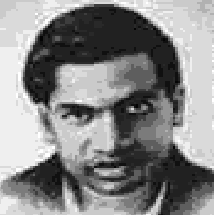PROFILE OF THEMONTH : AIYANGAR RAMANUJAN

Born
: 22 Dec 1887 in Erode, Tamil Nadu state, IndiaDied: 26 April 1920 in Kumbakonam, Tamil Nadu state, India
Srinivasa Ramanujan was one of India's greatest mathematical geniuses. He made substantial contributions to the analytical theory of numbers and worked on elliptic functions, continued fractions, and infinite series. Ramanujan was born in Erode, a small village about 400 km South west of Madras.
In 1900 he began to work on his own on mathematics summing geometric and arithmetic series. By 1904 Ramanujan had begun to undertake deep research. He investigated the series (1/n) and calculated Euler's constant to 15 decimal places. He began to study the Bernoulli numbers, although this was entirely his own independent discovery. He continued his mathematical work on hyper geometric series and investigated relations between integrals and series. He also studied continued fractions and divergent series in 1908. On 16 March 1916 Ramanujan graduated from Cambridge with a Bachelor of Science by
Research (the degree was called a Ph.D. from 1920). He had been allowed to enrol in June 1914 despite not having the proper qualifications. Ramanujan's dissertation was on highly composite numbers and consisted of seven of his papers published in England.
Ramanujan independently discovered results of Gauss, Kummer and others on hyper geometric series. Ramanujan's own work on partial sums and products of hyper geometric series has led to major development in the topic. Perhaps his most famous work was on the number p(n) of partitions of an integer n into summands. Ramanujan left a number of unpublished notebooks filled with theorems that mathematicians have continued to study. G N Watson, Mason Professor of Pure Mathematics at Birmingham from 1918 to 1951 published 14 papers under the general title Theorems stated by Ramanujan and in all he published nearly 30 papers which were inspired by Ramanujan's work. Hardy passed on to Watson the large number of manuscripts of Ramanujan that he had, both written before 1914 and some written in Ramanujan's last year in India before his death.
The picture is taken from a stamp issued by the Indian Post Office to celebrate the 75th anniversary of his birth